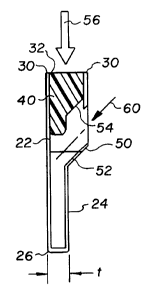Some of the information on this Web page has been provided by external sources. The Government of Canada is not responsible for the accuracy, reliability or currency of the information supplied by external sources. Users wishing to rely upon this information should consult directly with the source of the information. Content provided by external sources is not subject to official languages, privacy and accessibility requirements.
Any discrepancies in the text and image of the Claims and Abstract are due to differing posting times. Text of the Claims and Abstract are posted:
| (12) Patent: | (11) CA 2237539 |
|---|---|
| (54) English Title: | INTEGRALLY ATTACHED AND OPERABLE MULTIPLE REACTION VESSELS |
| (54) French Title: | RECIPIENTS POUR REACTIONS MULTIPLES INTEGRALEMENT CONTIGUS ET UTILISABLES |
| Status: | Deemed expired |
| (51) International Patent Classification (IPC): |
|
|---|---|
| (72) Inventors : |
|
| (73) Owners : |
|
| (71) Applicants : |
|
| (74) Agent: | GOWLING WLG (CANADA) LLP |
| (74) Associate agent: | |
| (45) Issued: | 2007-04-10 |
| (22) Filed Date: | 1998-05-13 |
| (41) Open to Public Inspection: | 1998-11-19 |
| Examination requested: | 2002-11-28 |
| Availability of licence: | N/A |
| (25) Language of filing: | English |
| Patent Cooperation Treaty (PCT): | No |
|---|
| (30) Application Priority Data: | ||||||
|---|---|---|---|---|---|---|
|
A reaction vessel for confined amplification and detection of nucleic acid material. The vessel features a plurality of adjacent chambers, each chamber comprising a front wall, a back wall, two side walls, and a bottom wall, the front and back walls terminating in an upper opening at a top edge of said front and back walls, a side wall of each chamber comprising a side wall in common with an adjacent chamber so as to integrally connect the chambers side-by-side; the front wall of each chamber including a liquid access port spanning all of the chambers below the top edge, the common side walls terminating at the port; and a movable elastomeric plug mounted within the upper opening above the port, shaped to block the port of each of the chambers and to stopper each the chamber when moved below the top edge, the plug spanning across all of the chambers in the vessel so as to close off the port simultaneously for all of the chambers when moved below the top edge.
Un récipient de réaction pour l'amplification et la détection confinées d'un matériau d'acide nucléique. Le récipient comporte une pluralité de chambres adjacentes, chaque chambre comprenant une paroi avant, une paroi arrière, deux parois latérales, et une paroi de fond, les parois avant et arrière se terminant par une ouverture supérieure à un bord supérieur desdites parois avant et arrière, une paroi latérale de chaque chambre comprenant une paroi latérale en commun avec une chambre adjacente de façon à relier solidairement les chambres côte-à-côte la paroi frontale de chaque chambre comprenant un orifice d'accès de liquide couvrant toutes les chambres au-dessous du bord supérieur, les parois latérales communes se terminant au niveau de l'orifice d'et un bouchon en élastomère mobile monté à l'intérieur de l'ouverture supérieure au-dessus de l'orifice, en forme de bloquer l'orifice de chacune des chambres et à chaque arrêt de la chambre lorsqu'elle est déplacée au-dessous du bord supérieur, le bouchon s'étendant à travers toutes les chambres de la cuve de façon à obturer l'orifice simultanément pour toutes les chambres lorsqu'elles sont déplacées au-dessous du bord supérieur.
Note: Claims are shown in the official language in which they were submitted.
Note: Descriptions are shown in the official language in which they were submitted.

For a clearer understanding of the status of the application/patent presented on this page, the site Disclaimer , as well as the definitions for Patent , Administrative Status , Maintenance Fee and Payment History should be consulted.
| Title | Date |
|---|---|
| Forecasted Issue Date | 2007-04-10 |
| (22) Filed | 1998-05-13 |
| (41) Open to Public Inspection | 1998-11-19 |
| Examination Requested | 2002-11-28 |
| (45) Issued | 2007-04-10 |
| Deemed Expired | 2016-05-13 |
There is no abandonment history.
Note: Records showing the ownership history in alphabetical order.
| Current Owners on Record |
|---|
| ORTHO-CLINICAL DIAGNOSTICS, INC. |
| Past Owners on Record |
|---|
| JOHNSON & JOHNSON CLINICAL DIAGNOSITICS, INC. |
| MACDONALD, STUART GILMOUR |